Lake Manitou
Experience Our Beautiful Lake
This large lake was created in 1827 by the U.S. Government building a dam that flooded 5 small lakes. Cottages around the lake have changed from summer rentals to year-round living. The lake has 775 acres and is about 25 to 45 feet deep in places, which makes it a fantastic destination for fishing, boating, and jet-skiing.
In the early 1900s there were no public beaches left due to land development, so Rochester built a beach and boat landing next to Indiana 14 and East 9th Street. The local dam has a historical marker sharing more information about Lake Manitou and Tiptonville.
Today Lake Manitou is a great fishing site and fun place for boating and jet skiing. The Lake Manitou Association holds a parade of boats, historic tours, and other events throughout the year.
Historical Events

Lake Manitou History Roaring 20’s Pontoon Tour
Welcome Aboard the “New” Pastime! We’re stepping back into history aboard a fleet of pontoons that represent the famous boat that toured the waters of Lake Manitou during the 1920s.
The original Pastime was a lake fixture for 20+years during the late ’20s, ’30s, and ’40s. This double-decker wooden excursion boat had a 60-person capacity. It was docked by the Colonial Hotel and cruised passengers around the lake while stopping at the main hotels: Fairview, Westside, Colonial, and Dam Landing Hotel. The tour cost a grand total of 25 cents!
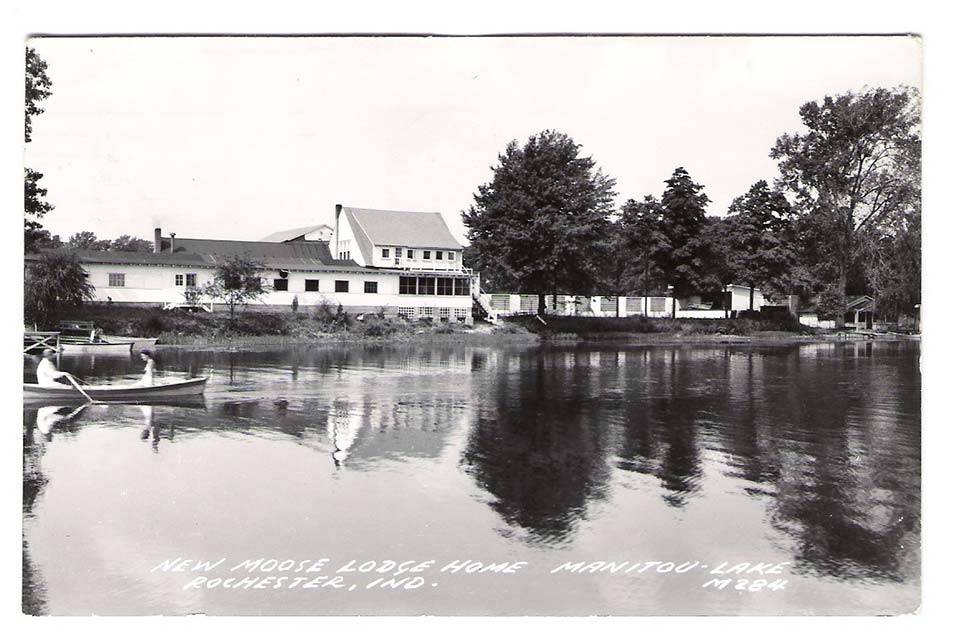
West Side Hotel
In 1880 the area where West Side Hotel is located was called Jewel Beach, as it has always been a beautiful natural sand beach on Lake Manitou.
West Side Hotel, a single-story structure with rooms and boats to rent, was the first structure built on this side of the lake. By 1914, the popularity of this resort as both a great place for Sunday dinner and a wonderful view of the lake, led to its second story expansion. Sailing, as well as fishing, were leisurely ways for visitors and residents alike to enjoy the lake.
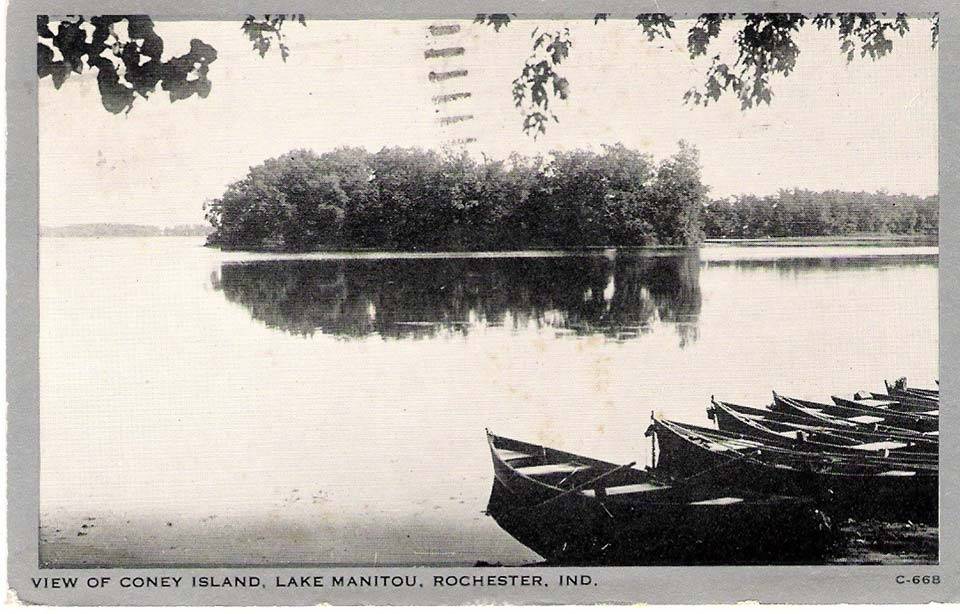
Lake Manitou & The Dam
For most of its early history, Lake Manitou was a fishing lake in both the summer and winter. There are bass, both black and largemouth, crappie, bluegill, spotted gar, northern pike, yellow perch, shad, sunfish, and carp.
In the early days of the lake, Duck Landing rented rowboats and there were fishing cottages all along Mitchell Park Drive. Wooden rowboats were rented for 10 cents the first hour and 5 cents each additional hour. Past Mitchell Park is Sunset Bay, quite a fishing haven in the early days of the Lake, and in the middle of Sunset Bay is Coney Island.
All the islands are privately owned by Lake Manitou. Coney Island gets its electricity from land with an underwater cable. Like many of the islands, this one has been ravaged by beavers killing the trees, and waves eroding the shoreline.
There are six islands in the main lake: Coney, Big Island, Honey Moon, and Treasure Island. On the south end or “Head of the Lake”, there are numerous smaller islands in the marshes that are simply referred to as The Manitou Islands.
Big Island can be spotted in the center of the lake and even though it looks like one island, there are three islands each with different owners. All three islands have cottages on them, but the only electricity provided is through generators.
Honeymoon Island is still an island but is disappearing due to erosion. In the 1950s, a small cottage was placed on the island but has since been torn down.
Lake Manitou wouldn’t exist without the dam. Prior to the dam and mill being built, there were five ponds. In the treaty of 1826, the federal government promised the Potawatomi that a dam and a mill would be built. In 1827, with the creation of the dam, the 775-acre Lake Manitou was formed.
The first settlement in Fulton County, Tiptonville, was created after the mill was built. The dam, mill, and the settlement fell into disuse when the Potawatomi were removed to Kansas in 1838.

The Dam Landing & Lakeside Park
In the early 1900s, the Dam Landing offered food, lodging, and boat rentals. In 1920 the Dam Landing Hotel became a two-story establishment featuring famous fish dinners and today, Dam Landing Restaurant is the only private restaurant on Lake Manitou. You can still park your boat and dine on certain days of the week at the Moose, Elks, and VFW lodges.
Lakeside Park is located right next to the dam on the north side where Bailey’s Ice House once stood. Visitors can enjoy a picnic pavilion, swimming area, boat ramp, and fishing piers. Prior to the park being built in the 1930s, the entire area was a fish hatchery that extended across the highway and is now the current location of Lakeview Park and Mill Creek Golf Course.

Devil’s Lake
Did you know that early settlers knew Lake Manitou as “Devil’s Lake”? Lake Manitou, Manatau, or Manitou, derives its name from the Potawatomi word used for “good spirit” and “evil spirit.” The indigenous people never lived upon its banks as they believed that the lake’s waters held a monster fish or serpent with supernatural powers.
The Logansport Telegraph described the Manitou Monster on July 21, 1838 newspaper, when two men reported spotting the monster and describing it as, “sixty feet long, and looked like a huge snake”. The famous painter of Native Americans, George Winter sketched his conception of the monster for the newspaper.
In 1849, the Logansport Journal reported that a huge buffalo carp that weighed several hundred pounds was caught in the lake. The fish’s thirty-pound head was later on exhibit in Logansport. In 1888, a 116-pound spoonbill catfish was pulled from the lake by four men. The monster-sized fish was put in the horse trough and displayed at the courthouse in Rochester. People were then charged 10 cents a peek. Eventually, the catfish was butchered and sold for 10 cents a pound.
In recent years, reports of the Lake Manitou monster have waned. Today when the northern Indiana winters freeze the lake over, the ice shifts and emits booming and roaring noises. Residents around the lake smile and say that it’s the monster trying to force its head above the ice.
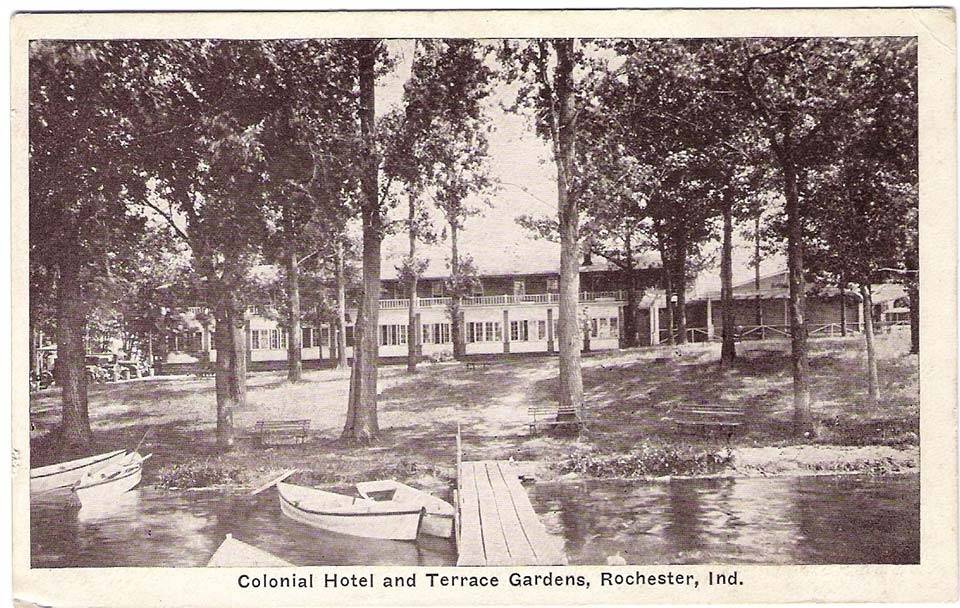
The Colonial Hotel & Terrace Gardens
Right across from the dam is an area that was originally known in the 1890s as Columbia Park. Within the Columbia Park area, the Colonial Hotel and Terrace Garden were established around 1910. The hotel was in full swing by the 1920s and a dance pavilion was added in 1927. It is even rumored that gangsters visited the hotel!
In October of 1938, a terrible fire destroyed the entire hotel. After the fire, the hotel property was sold to Harry Paige and rebuilt to be an even more attractive destination. Big names such as Glen Miller, Duke Ellington, Cab Calloway, and Louis Armstrong were regular headliners.
The Colonial became a Midwest attraction as big bands played and crowds came by train and automobile to dance on the open floor under the stars. In the late 1940s-50s, swing music was declining in popularity, so The Colonial continued as a restaurant until 1977 when it was torn down. The Colonial Condos were built in 1982 and remain standing today.
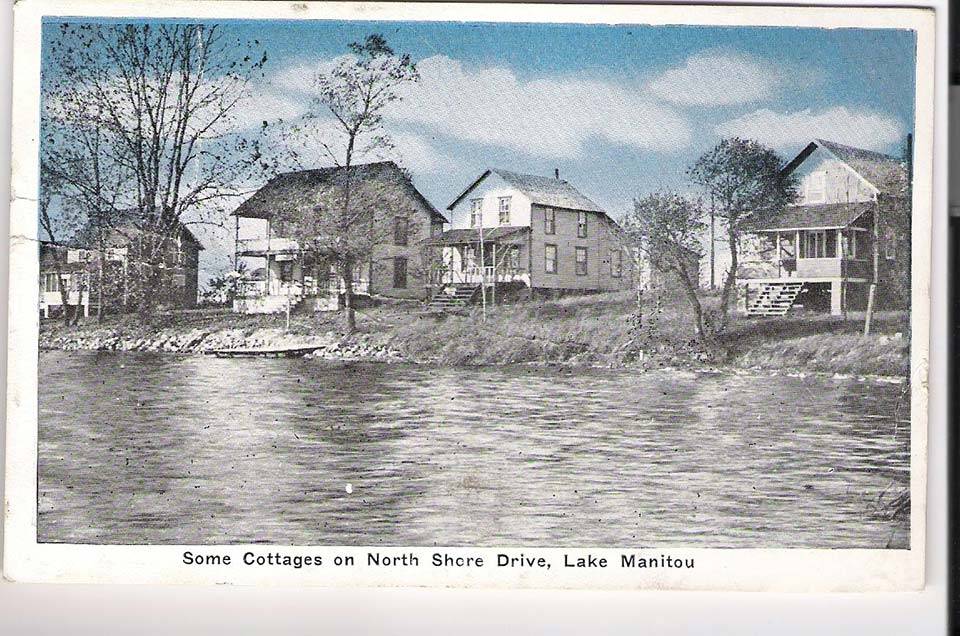
Lily Pond
As one heads east, there is a section of the lake known for its many lily pads. This was Lily Pond and the point before entering it was known as the Poet’s Point.
The Lake Manitou cottages had no heat in the winter but there were large porches facing the lake with lots of windows to catch the summer breezes off the pond and many were two stories to give visitors a better view.

Public Access Points
At the beginning of Country Club East is the larger of the two public access points. This one is owned by the Department of Natural Resources and the one by the dam is owned by the City of Rochester. In 1987 the entire lake was annexed into the city limits of Rochester.

Barrett Road
At the end of Barrett Road was an amusement park billed as the Lake’s best swimming beach: Long Beach Amusement Park. The park was owned by A. J. Barrett. This area operated for 15 years until 1937. It had a diving pier, toboggan (water slide), dance pavilion, and a hotel. The beach was also known as White City.
The shoreline turns at Long Beach and follows Bessmore Park Road heading toward White Creek. The other creek that feeds into the lake and natural springs is Rain Creek at the south end of the lake. This area is rather shallow at 4-5 feet deep, which leads to the question, “how deep is this lake and what is the bottom like?”
Because of the way the lake was formed from five ponds due to the dam, the average depth in this area is around 4-5 feet, but where the ponds were, the lake can get as deep as 25-45 feet. The bottom is technically classified as sand, but because of years of heavy weed growth and natural forming muck, there are certain sections with vast amounts of silt.

Rochester Country Club & The Fairview Hotel
Country Club Drive East turns abruptly south and becomes Country Club Drive South. The area gets its name from the Rochester Country Club, which later became the Elks Club. This was the first club in the county to have a nine-hole golf course which remains today
But long before the Country Club and further south along the Lake was another great hotel, The Fairview. In the 1850s, the land was purchased by the Cincinnati, Peru, and Chicago Railroads to speculate on the lands along lakes in northern Indiana as possible resorts.
122 acres were purchased for an unknown sum but appraised at $21,400 in 1854. Obviously, it was a huge, over-valued speculative venture, because, in 1859, the railroad sold 94 acres off for $5,000. The same 94 acres were sold to Samuel Sibert in 1868 for $1,500. In 1908, the area was platted as Best View and still maintains that name.

The East Side Hotel
Starting in the 1870s a series of hotels were built at the east end of the lake. The East Side Hotel was a two-story, rather plain wooden structure when it was purchased by Harry Paige in 1910. He transformed it into the Fairview Hotel and Gardens.
The Fairview too became a destination for rail travelers getting off at Rochester and taking carriages or horseless carriages to the dance pavilion, bathing beach, and the restful atmosphere of Fairview Gardens. The dance floor, built in 1915, was the first open-air dance pavilion in the Midwest. In 1939, three months after The Colonial burned down, the Fairview also burned, never to be rebuilt. Private residences now occupy the site today.
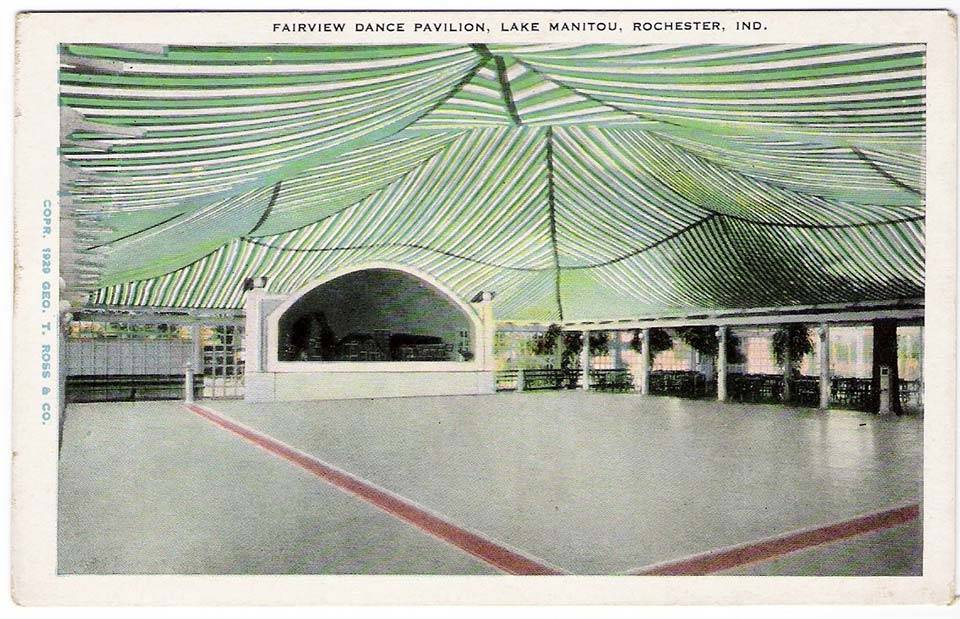
The Headlands
Past the former spot of the Fairview are the “Headlands” of the lake: a beautiful, natural wildlife refuge that is the largest wetlands in Northern Indiana. The Manitou Islands Wetlands include 643 acres. Two local families sold a significant amount of ground to the wetlands to enhance the area even further. This land became the Judy Burton Nature Preserve (130 acres) and the Bob Kern Nature Preserve (162 acres).
On the southeast side of the wetlands, across the southern edge of the lake, are the houses of the Goose Pond Road. Many of these houses are at the site of the former Sportsman Restaurant. Empty lots have become a rarity on the Lake and older buildings often need to be torn down for something new to be built.
Past the houses on Goose Pond Road is the opening to the lake’s channels. In the 1960s, the Meiser brothers channeled the wetlands that now exist in this area. They made an entire series of 15 ft.-deep channels. Today, channeling is not allowed because of the destruction of protected wetlands.
When the channels were dredged, a passageway was opened to the lake where the island first known as Round Top can be seen. Today, the island is called Treasure Island and still has the original 1920s cottage.
The house has been completely remodeled and has all the comforts of a new, year-round home. Electricity, cable, phone, and Internet are provided by overhead wires because the island is close enough to shore. A truly massive seawall surrounds half of this 1 ½ acre island which protects it from erosion from the waves.
Traveling down Wolfs Point Road, one can see that many of the older cottages have been replaced by new, beautiful homes. After rounding Wolfs Point Drive and heading west, one can see that today’s houses are just like those of the turn of the century: featuring plenty of windows and multiple stories so their residents can enjoy the view.
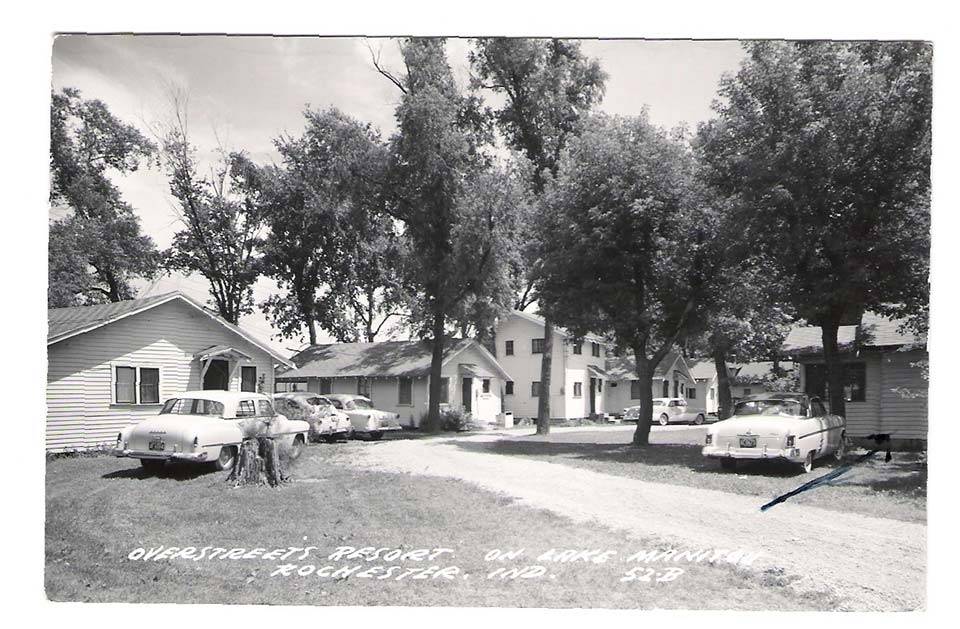
Condominiums On The Lake
As we approach the other set of condominiums on the lake, we see another former great swimming spot: Overstreet’s Resort. A school teacher named Kenneth Overstreet bought all of Wolf’s point in 1938. He had swimming, concessions, boat and cottage rentals available at the resort and it stayed open until the 1970’s and then went through various owners. Homes and the condominiums have since replaced Overstreet’s resort.